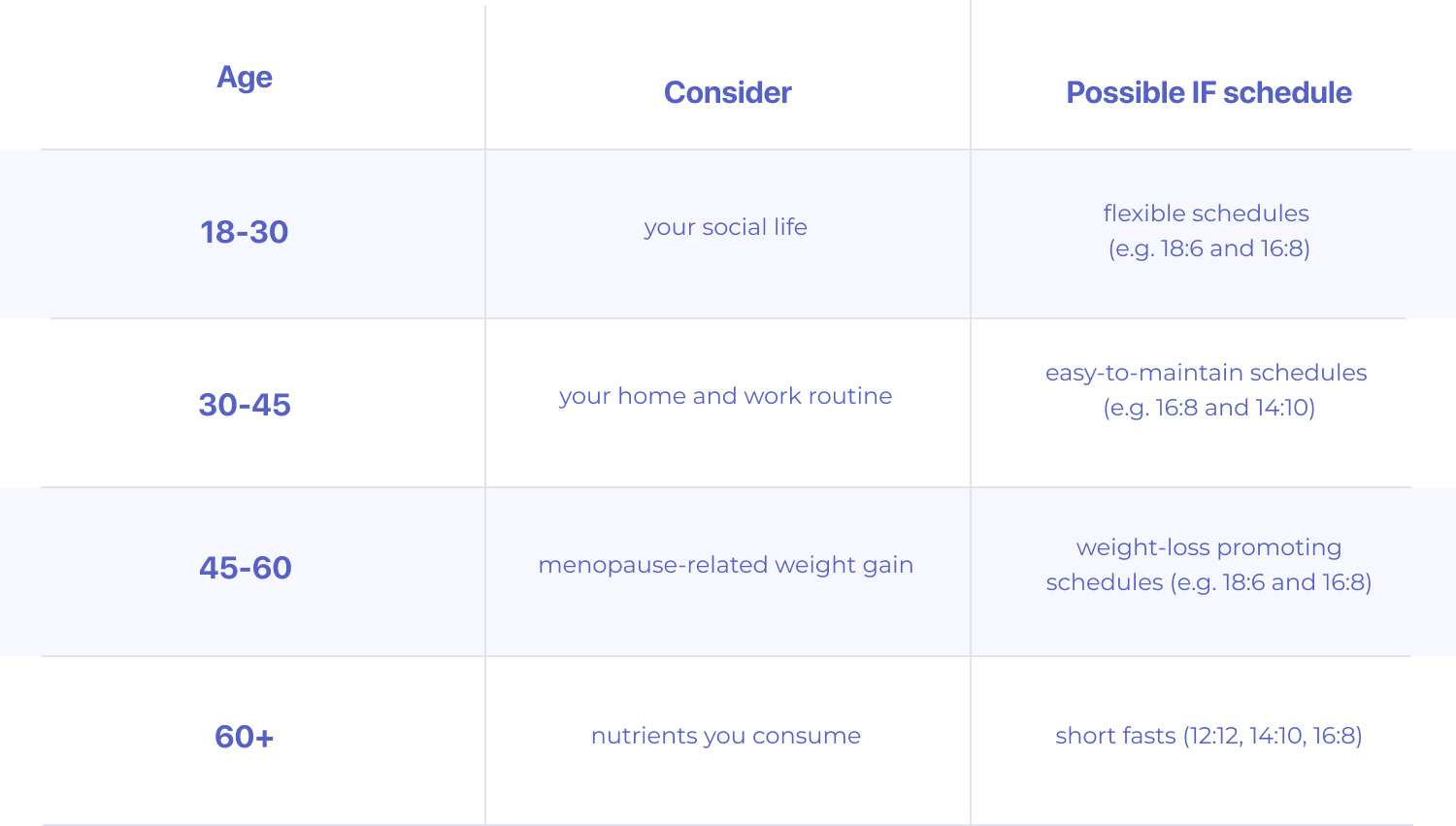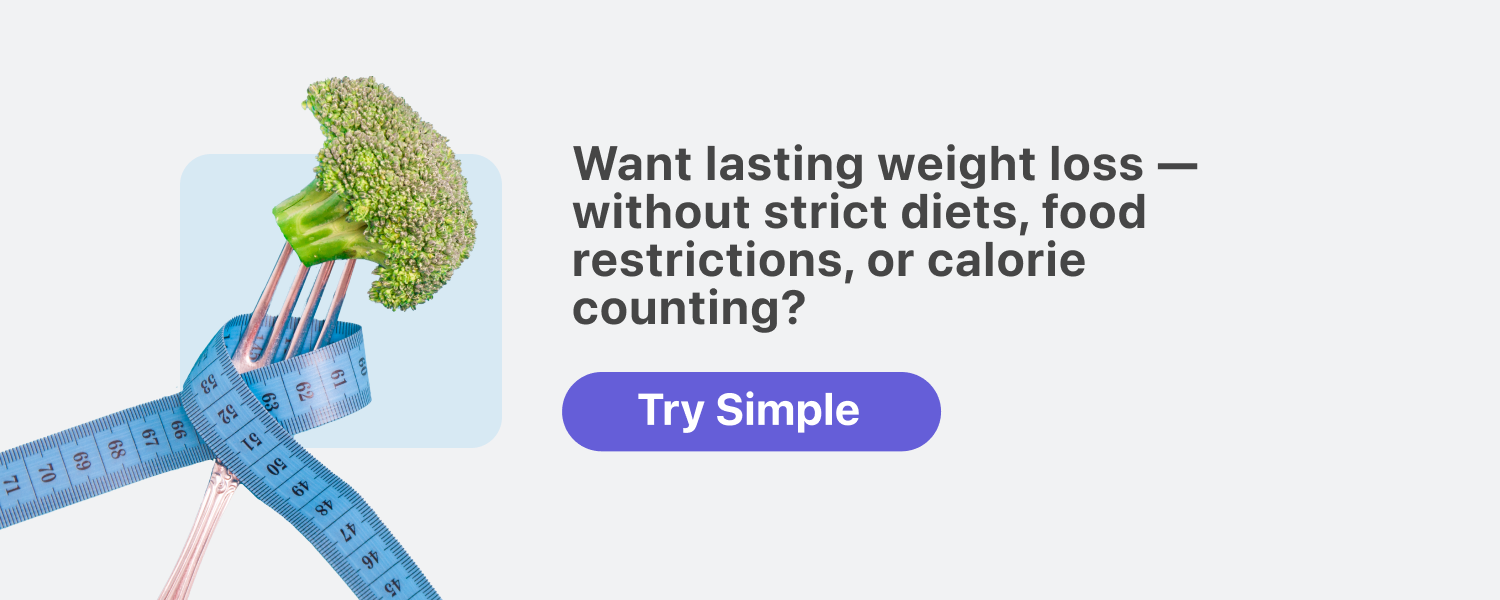Intermittent fasting by age chart — explained by Simple

Intermittent fasting is an approach to eating that involves daily or weekly fasts (periods of time when you don’t eat) and has been linked to benefits like weight loss, supporting our immune function, reducing inflammation, and even supporting gut health.[1,2,3,4]
You may have heard that you can determine your best intermittent fasting schedule by using your age. For instance, maybe it’s the case that 14-hour fasts work better for 30-somethings, whereas those who are 50+ would be better off doing 16:8.

Is there any truth in all this? Can you gauge the right intermittent fasting schedule for you just by your age group? Let’s chart these waters and find out.

Intermittent fasting by age
At Simple, we like to keep things real and honest. So here’s the deal:
There’s no scientific evidence to say what difference, if any, age makes to the effectiveness of fasting.
Research on intermittent fasting has been carried out on all ages (yes, even centurions!), so it’s hard to say which schedule fits who best. What research does say, though, is that all sorts of fasting schedules are generally safe and effective for adults of all ages, so long as those adults are safe to fast.
As the science isn’t there, we spoke to our expert team — who’ve worked with many fasters in both a clinical and research setting — to learn their firsthand experiences of which intermittent fasting schedule worked better for different age groups and why.
From their insights, we’ve put together some practical ideas about what to consider when choosing an intermittent fasting schedule according to your age.
If you’re in the 18–30 age group
Find an intermittent fasting schedule that suits your social time
Maybe it’s a game of beer pong with college pals, debriefing after work with colleagues over ramen, or spending Sunday evening discussing the latest episode of your fav show over some wine and cheese with friends — food and drink are an integral part of social life for many 18- to 30-year-olds.[5]
If you’re at the social butterfly stage of life (whatever age you are, being social doesn’t have an age limit), choosing an intermittent fasting schedule you can adjust manually could be ideal, as you’re able to fit your fasting around your social time.
For example, say you usually fast on an 18:6 schedule. But this weekend you’re planning to hit late-night tacos with your workmates, then go into a big celebration for your best friend’s birthday. No worries! Switch to 14:10 to give yourself a longer eating window on these days, then flip back to 18:6 on Monday.
You can mix it up as much as you need — your fasting window doesn’t have to be the same length every day to be effective.
If you’re in the 30–45 age group

Find an intermittent fasting schedule that fits your home / work life
Maybe you got that promotion you were chasing in your 20s (congrats, btw!), and now, you’re juggling alllll the tasks: dinner with family, plus that last-minute task your boss sent you (thanks for that, boss), plus getting your work clothes dry-cleaned, plus staying up late to get some me-time, plus, plus, plus …
Whew. It’s a lot.
That busy lifestyle is a key factor when you’re finding an intermittent fasting schedule that works for you. Whichever fasting schedule gives you sufficient time and space to eat and nourish that busy body and mind — without adding more stress to your life — that’s the winner.
Perhaps 16:8 could be a good fit in general. Or maybe 14:10. Again, taking a manual approach where you flex your fasting window to fit the needs of your day will likely work best.
Why not try our Simple quiz and use the app to get your fasting schedule set up? You’ll be able to control how long you fast each day, and it’ll help you keep track of where you’re at each day (that’s one less thing to remember!).
If you’re in the 45–60 age group
Find an intermittent fasting schedule that supports menopause-related weight gain
If you’re experiencing menopause-related weight gain, know that you are not alone. Many women are right there with you. It can be a tough time in life.
Here’s the good news: intermittent fasting could help. Short-term studies show both pre- and post-menopausal women can lose fat with intermittent fasting schedules like 18:6.[6]
Other actions we’d suggest are:
- making sure to eat enough protein
- adding strength training to your weekly routine, if you can
Both of these will help keep your muscles healthy so you can stay strong and mobile.
If you’re in the 60+ age group
Choose an intermittent fasting schedule that makes it easier to get all the nutrients you need
As we get older (and hopefully wiser), we need extra nutrients — like protein, calcium, and vitamin D — to continue to thrive.[7,8]
So if you’re intermittent fasting in this age group, err on the side of shorter fasts like 12:12, 14:10, or 16:8 to give yourself plenty of time to eat everything you need to look after your body.
Again, exercise — all kinds, but especially strength training — can be a real bonus at this age too. (Truthfully, we’d suggest intermittent fasters of all ages to go get their lifting on!)
An all-age-group note
Taking medication?
Of course, medication can be taken at any age. Yet, we tend to use more medications as we get older.
If you’re taking anything, be sure to check in with your doctor before starting any intermittent fasting schedule, and continue taking them as prescribed (with food, on an empty stomach, etc.) even if you’re doing intermittent fasting.
Intermittent fasting by gender
Does intermittent fasting affect men and women differently?
Because there are differences in how women’s bodies work compared to men’s — like hormones, the impact of calorie restriction, response to stress, etc. — women can experience intermittent fasting in ways that men don’t.
This means that some women may respond well to gentler intermittent fasting schedules and a slower introduction to fasting, like starting with 12:12 and working up to longer fasts over time.
For a fuller breakdown, check out our guide on how intermittent fasting affects women.
There are also social differences, which can also come into play when considering which intermittent fasting schedule to choose.
For instance, women still tend to do more caregiving and may have to juggle their eating habits more around kids, animals, and wider family needs.[9] Men still tend to do more hours in the office, so they may need to juggle their eating times around meetings, long hours, and work trips.[10]
Of course, these are generalizations, and typical gender roles may or may not factor into your approach to intermittent fasting. What matters is that you build your plans around your needs, whatever drives them.
Intermittent fasting chart by age
Check out our intermittent fasting chart by age and gender to get a handy summary of everything we’ve just discussed.

How does intermittent fasting work?
When you are intermittent fasting, your body goes from using glucose for energy to using stored fat. This is because your body needs a source of energy when you’re fasting since no glucose is coming in.
It’s this metabolic shift, called ketosis, and the natural lowering of calories due to a shorter eating window that leads to weight loss and a lot of the health benefits intermittent fasting offers.
Of course, intermittent fasting tends to work better if you work it. For a deep dive on kicking butt with intermittent fasting, here are your Must-Reads.
- Learn what you can drink while fasting. (Spoiler alert: tea and coffee [without milk or sugar] and water are your friends.)
- Get to grips with what to eat during intermittent fasting for goal-crushing nutrition. (Spoiler alert: vegetables and protein feature strongly.)
- Build your how-to-meal-plan skills. (Spoiler alert: planning ahead makes your food choices better.)
- Prepare for the most common intermittent fasting side effects. (Spoiler alert: feeling hungry and headaches are a couple.)
- Bookmark this troubleshooting guide for those plateau moments when you’re not seeing results and it feels like intermittent fasting is not working. (Spoiler alert: sleep, eating enough, and getting active are in the mix.)
Oh, and if you’re wondering, “Does intermittent fasting slow metabolism?” the answer is no. That consequence of calorie reduction doesn’t seem to happen so much with intermittent fasting.

The different types of intermittent fasting
There are a number of intermittent fasting schedules to choose from. This wide variety is one of intermittent fasting’s most winning features — there’s something for everyone.
For the complete 411 on this, our intermittent fasting for beginners guide has you covered, but for the TL;DR version, read on!
Simple-approved
Time-restricted eating
Time-restricted eating can be done in lots of ways. Two solid options are:
16:8
Intermittent fasting on a 16:8 schedule means fasting for 16 hours and eating within an 8-hour window. Here, you can choose to either skip breakfast or have your evening meal a little earlier in the day. It all depends on what works best for you!
18:6
18:6 intermittent fasting is a type of time-restricted eating where you fast for 18 hours and eat within a 6-hour window each day.
Other popular TRE schedules include 12:12 and 14:10, and you can go off script here, too, to try something like 15:9 if it fits better! We are big fans of any TRE option that involves less than 18 hours of fasting, but it’s still a good idea to check in with your doctor before making any significant changes to your eating habits or lifestyle.

Medical approval needed
While we always recommend consulting your healthcare team before modifying your eating routine, getting medical approval / support is particularly critical when it comes to more restrictive fasts where you go without food or with limited caloric intake for 18+ hours.
So, proceed with extra caution if you’re interested in any of the fasting schedules below, and make sure to get the green light from your healthcare team before giving them a try.
The 5:2 diet
The 5:2 diet involves eating normally for five days a week and restricting your calorie intake to 500–600 calories for two non-consecutive days in the week.
Alternate-day fasting (ADF)
Alternate-day fasting is a type of intermittent fasting where you alternate between eating as you normally would one day and significantly reducing your calorie intake on the next.
20:4
Intermittent fasting 20:4 is a type of time-restricted eating where you fast for 20 hours and eat within a 4-hour window each day.
Water fasting
With water fasting, you consume only water for a specific period of time, typically ranging from 24 hours to several days or even weeks.
OMAD
The OMAD (One Meal a Day) diet involves eating only one meal per day, typically within a one-hour window, and fasting for the remaining 23 hours.
Eat Stop Eat
Eat Stop Eat involves fasting for 24 hours once or twice a week, consuming no calories during the fast, and then returning to normal eating patterns.
If this list has you feeling a little overwhelmed, why not try our Simple quiz and let us take the load off your shoulders? We can give you a leg up by suggesting a fasting schedule based on what you tell us about yourself.
Who shouldn’t try intermittent fasting?
While intermittent fasting is generally safe and healthy for adults of all ages, some folk shouldn’t try it unless they have full permission and support from their doctor.
That means you if you’re someone who:
- is pregnant, breastfeeding, or trying to conceive
- is under a lot of stress
- has a body mass index (BMI) lower than 18.5
- is very active and/or has high daily energy demands
- is under 18 or 80 years or older
- has nutritional deficiencies
- has a health condition, like diabetes or anemia
- has (or is at risk of having) an eating disorder or has a history of one
- takes medications (especially those that affect blood glucose or blood pressure levels)
Is intermittent fasting safe for kids?
Sorry kiddos, intermittent fasting isn’t really recommended for you.[11]
If you’re under 18, you’re still growing, so you need regular meals and snacks to get all the nutrients you need. Fasting can result in nutrient deficiencies that can impact your growth, development, energy levels, concentration, and overall well-being.
While there is research in adolescents emerging,[12] at Simple, we still think it’s too soon to tell if intermittent fasting is safe for children and teens.[13] So, for now, we’ll leave it to the pediatricians and pediatric specialist dietitians to decide what’s best.
Frequently Asked Questions
There is no strict upper age limit for intermittent fasting, but it’s not recommended for those under 18 or 80 years or older, those who are pregnant or breastfeeding, those with eating disorders, or individuals with certain medical conditions.
How long a 40-year-old should intermittent fast for is up to them. Intermittent fasting is flexible, and the best schedule for anyone in their 40s depends on their preferences and lifestyle. They have the full suite to choose from, should they wish!
Intermittent fasting can be good for those over 50.[15] It can help you be more mindful of food, combat menopause-related weight gain, and lower the risk of conditions like diabetes. Do make sure to chat with a doctor first if you have any medical conditions.
Intermittent fasting can be done by 70-year-olds, but it’s important to approach it with caution and before making any decisions that may impact your health, always chat with your doctor.
How many hours a woman over 50 should fast is completely up to her and what she needs. Check out our ideas above.

- Welton S, Minty R, O’Driscoll T, Willms H, Poirier D, Madden S, Kelly L. Intermittent fasting and weight loss: Systematic review. Canadian Family Physician. 2020 Feb 1;66(2):117-25.
- He Z, Xu H, Li C, Yang H, Mao Y. Intermittent fasting and immunomodulatory effects: A systematic review. Frontiers in Nutrition. 2023 Feb 28;10:269.
- Wang X, Yang Q, Liao Q, Li M, Zhang P, Santos HO, Kord-Varkaneh H, Abshirini M. Effects of intermittent fasting diets on plasma concentrations of inflammatory biomarkers: a systematic review and meta-analysis of randomized controlled trials. Nutrition. 2020 Nov 1;79:110974.
- Pérez‐Gerdel T, Camargo M, Alvarado M, Ramírez JD. Impact of Intermittent Fasting on the Gut Microbiota: A Systematic Review. Advanced Biology. 2023 Mar 22:2200337.
- Moutinho LS, Mendes AM, Lopes M. Alcohol Consumption and Binge Drinking Among Young Adults Aged 20–30 Years in Lisbon, Portugal. Journal of addictions nursing. 2018 Oct 1;29(4):E9-15.
- Cienfuegos S, Gabel K, Kalam F, Ezpeleta M, Lin S, Varady KA. Changes in body weight and metabolic risk during time restricted feeding in premenopausal versus postmenopausal women. Experimental Gerontology. 2021 Oct 15;154:111545.
- Deutz NEP, Bauer JM, Barazzoni R, Biolo G, Boirie Y, Bosy-Westphal A, et al. Protein intake and exercise for optimal muscle function with aging: recommendations from the ESPEN Expert Group. Clin Nutr. 2014 Dec;33(6):929–36.
- My Plate. U.S . Department of Agriculture. Older adults [Internet]. 2020-2025.
- Barger A., Best C. The State of Women and Caregiving [Internet]. Caregiving.Com. 2022 Feb.
- Doyle A. What are the average hours worked per week in the US? [Internet]. The Balance. 2022 Sep.
- Whyte HE, Findlay SM, Canadian Paediatric Society, Adolescent Health Committee. Dieting in adolescence. Paediatrics & Child Health. 2004 Sep 1;9(7):487-91.
- Jebeile H, Gow ML, Lister NB, Mosalman Haghighi M, Ayer J, Cowell CT, Baur LA, Garnett SP. Intermittent energy restriction is a feasible, effective, and acceptable intervention to treat adolescents with obesity. The Journal of Nutrition. 2019 Jul 1;149(7):1189-97.
- Ganson KT, Cuccolo K, Hallward L, Nagata JM. Intermittent fasting: Describing engagement and associations with eating disorder behaviors and psychopathology among Canadian adolescents and young adults. Eating Behaviors. 2022 Dec 1;47:101681.
- Abeyasekera KN. Benefits of Intermittent Fasting: A Systematic Review of Randomized Clinical Trials.
- Anton S, Ezzati A, Witt D, McLaren C, Vial P. The effects of intermittent fasting regimens in middle-age and older adults: Current state of evidence. Experimental Gerontology. 2021 Dec 1;156:111617.
